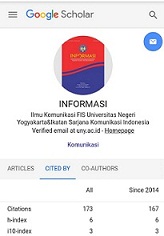Investigating vertical social media impact through influencer on risky sexual behavior among adolescents in Indonesia
DOI:
https://doi.org/10.21831/informasi.v51i2.40900Keywords:
Social Media Influencer, Risky Sexual Behavior, AdolescentAbstract
References
Al-Anshori, A. N. (2020, September 9). Data Badan Pusat Statistik: Angka Pernikahan Dini di Kalimantan Selatan Tertinggi di Indonesia. Retrieved Oktober 12, 2020, from Liputan6.com: https://www.liputan6.com/health/read/4351605/data-badan-pusat-statistik-angka-pernikahan-dini-di-kalimantan-selatan-tertinggi-di-indonesia
Amiyni, I. (2017). Faktor-faktor yang berhubungan dengan perilaku seksual beresiko di salah satu SMA Negeri Kota Padang. Universitas Andalas.
Baharuddin, N. A., & Yaacob, M. (2020). Dimensions of eWOM credibility on the online purchasing activities among consumers through social media. Jurnal Komunikasi: Malaysian Journal of Communication vol 36 (3), 335-352 https://doi.org/10.17576/JKMJC-2020-3603-21.
Connoly, B. (2017, December 5). Why consumers follow, listen to, and trust influencers. Retrieved June 27, 2019, from Olapic: https://www.olapic.com/resources/consumers-follow-listen-trustinfluencers_article/
Febriani, Z., & Ranakusuma, O. I. (2020). Perilaku online beresiko remaja: Hubungannya dengan kualitas hidup dan mediasi orang tua. Jurnal Psikogenesis, 8(1). 89-100.
Festi, R., & Quandt, T. (2020). Cyberbullying, online addiction, and sexting. In M. N. Potenza, K. Faust, & D. Faust, The oxford handbook of digital technologies and mental health (pp. 259-274). Oxford University Press.
Fitriyah, L. (2016). Eksperimentasi sebagai pintu perilaku beresiko pada remaja. Seminar ASEAN 2nd Psychology & Humanity (pp. 198-203). Psychology Forum UMM.
Handayani, T. K. (2011). Pembuatan animasi 3D organ reproduksi manusia untuk meningkatkan pemahaman remaja dalam penyuluhan kesehatan reproduksi remaja. Skripsi. UIN Syarif Hidayatullah.
Hidayangsih, P. S. (2014). Perilaku berisiko dan permasalahan kesehatan reproduksi pada remaja. Indonesian Journal of Reproductive Health, 5(2), 89-101.
Jin, S. V., Muqaddam, A., & Ryu, E. (2019). Instafamous and social media influencer marketing. Marketing Intelligence & Planning, 37(5), 567-579. https://doi.org/10.1108/MIP-09-2018-0375.
Karouw, e. E., Worang, F. G., & Pandowo, M. H. (2019). Millennial trust through endorser credibility on local influencer endorsement on Instagram. JURNAL EMBA: JURNAL RISET EKONOMI, MANAJEMEN, BISNIS DAN AKUNTANSI, 7(3), 3818-3827.
Kasih, A. P. (2020, July 8). Pakar Unpad: Angka Pernikahan Dini Melonjak Selama Pandemi. Retrieved October 10, 2020, from Kompas.com: https://edukasi.kompas.com/read/2020/07/08/131828971/pakar-unpad-angka-pernikahan-dini-melonjak-selama-pandemi?page=all
KSR PMI Unhas. (2017). Fenomena Seks Bebas pada Kalangan Remaja di Kota Makassar. Diakses 15 Juli 2020 dari ksrpmiunhas.or.id: https://www.ksrpmiunhas.or.id/2017/11/fenomena-seks-bebas-pada-kalangan.html
Mulya, A. P., Lukman, M., & Yani, D. I. (2020). Correlation of media and parents role to adolescent sexual behavior in SMA Bandung. Journal Nursing Care, 3(3). 191-198.
Nelissen, S., Beullens, K., Lemal, M., & Bulck, J. V. (2015). Media use, cancer knowledge, and premarital relationship style choices: A cross-sectional analysis. European Journal of Public Health, March, 1-5 DOI: 10.1093/eurpub/ckv018.
Prajagopta, D. (2019). Gambaran pengetahuan, sikap, dan perilaku beresiko terhadap infeksi menular seksual (IMS) pada anak jalanan di Kota Medan. Universitas Sumatera Utara.
Pratomo, Y., & Yusuf, O. (2019, Mei 16). APJII: Jumlah Pengguna Internet di Indonesia tembus 171 Juta Jiwa. Retrieved Juni 26, 2019, from Kompas.com: https://tekno.kompas.com/read/2019/06/16/03260037/apjii-jumlah-pengguna-internet-diindonesia-tembus-171-juta-jiwa
Rai, R., & Tripathi, S. (2020). Consumer buying psychology and brand perception: Influence of word of mouth communication. Journal of Content, Community, and Communication. 12. 159-168. DOI: 10.31620/JCCC.12.20/15
Rizal, M. N. (2017, November 24). Menghadapi Era Disrupsi. Retrieved Juni 27, 2019, from Republika: https://www.republika.co.id/berita/jurnalisme-warga/wacana/17/11/24/ozw649440-menghadapi-era-disrupsi
Unicef, PUSKAPA, Bappenas, & BPS. (2020). Pencegahan perkawinan anak: Percepatan yang tidak bisa ditunda. UNICEF & PUSKAPA.
Vannucci, A., G. Simpson, E., Gagnon, S., & Ohannessian, C. M. (2020). Social media use and risky behaviors in adolescents: A meta-analysis. Journal of Adolescence, 79, 258-274.
Waheed, M. (2019). Online threats and risky behavior from the perspective of Malaysian youths. SEARCH 11(2), 57-71
we are social & Hootsuite. (2020, February 18). Digital 2020. (S. Kemp, Ed.) Retrieved October 10, 2020, from Datareportal: https://datareportal.com/reports/digital-2020-indonesia
Wed, E. N. (2020, August 13). Akibat Pergaulan Bebas Ratusan Remaja "Terpaksa" Menikah. Retrieved October 10, 2020, from news.okezone.com: https://news.okezone.com/read/2020/08/13/340/2261628/akibat-pergaulan-bebas-ratusan-remaja-terpaksa-menikah
Zhang, Y., Lin, Y., & Goh, K. H. (2018). Impact of online influencer endorsement on product sales: Quantifying value of online. Twenty-Second Pacific Asia Conference on Information Systems, Japan 2018 (p. 201). PACIS 2018 Proceedings.
Downloads
Published
How to Cite
Issue
Section
Citation Check
License
Authors who publish with this journal agree to the following terms:
- Authors retain copyright and grant the journal right of first publication with the work simultaneously licensed under a Creative Commons Attribution License that allows others to share the work with an acknowledgement of the work's authorship and initial publication in this journal.
- Authors are able to enter into separate, additional contractual arrangements for the non-exclusive distribution of the journal's published version of the work (e.g., post it to an institutional repository or publish it in a book), with an acknowledgement of its initial publication in this journal.
- Authors are permitted and encouraged to post their work online (e.g., in institutional repositories or on their website) prior to and during the submission process, as it can lead to productive exchanges, as well as earlier and greater citation of published work (See The Effect of Open Access).












